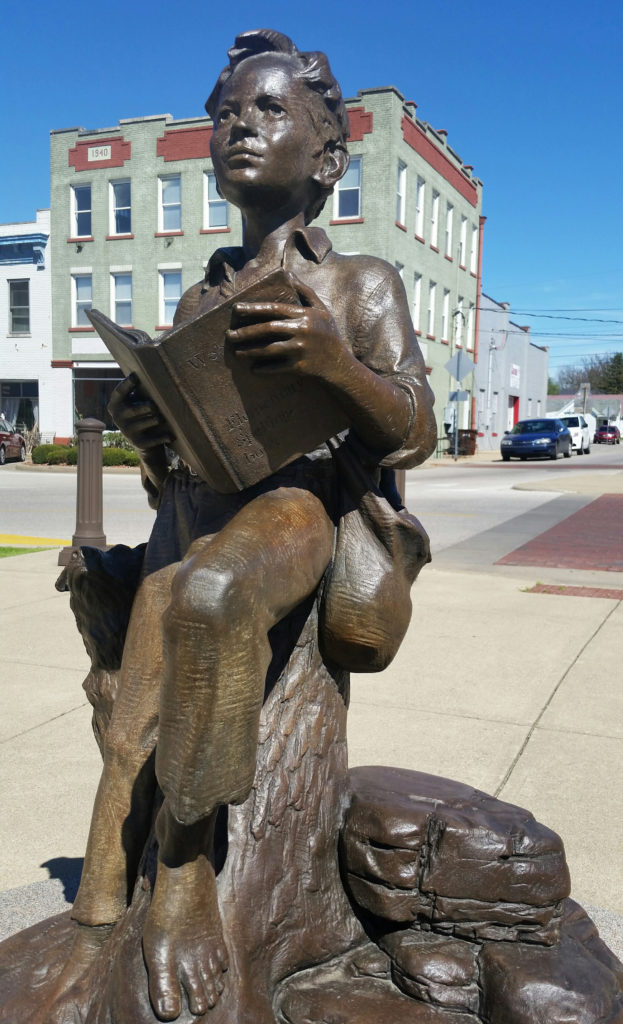
By Don Radebaugh — When I was 9 years old, I shut myself up in my room and cracked open a children’s biography on Abraham Lincoln. It was a fairly big book for a kid, and once I cleared the first chapter, I had no trouble at all staying with it. It intrigued me so much I didn’t come out of my room until I was finished. I never got over the experience, and I’ve been reading, studying Lincoln ever since.
It always amazed me that a man with no more than a year of formal education, completely self-taught on all the subjects could rise to be the President of the United States, and not just any President, but the best I believe America has ever known. His formal education consisted of “blab” schools that he and his sister Sarah would walk miles to during his youth in Kentucky and southern Indiana. They were called blab schools because lessons were read out loud because there was nothing to write on and often nothing to write with.
In a tiny rough-hewn log house with a dirt floor on the Sinking Spring Farm near Hodgenville, Kentucky, Abraham Lincoln came into the world on February 12, 1809. The farm was named after a sunken spring on the property which served as their water supply. The spring is still there, just in front of the 56 steps that lead to the enclosed log house, 56 steps for every year that Lincoln lived. The site is now part of the National Park Service. Lincoln only lived there for his first two years and had no memory of the place.

In 1811, the Lincolns moved. Land disputes among competing farmers prompted the move just 10 miles northwest to the Knob Creek Farm. Lincoln’s “earliest recollection is of the Knob Creek place.” It was there that Lincoln attended the blab schools, the first kept by Zachariah Riney, and the second by Caleb Hazel…subscription schools that typically lasted a few months. Lincoln lived at Knob Creek for a little more than five years before the family moved again, this time across the Ohio River to Spencer County Indiana where he spent his next 14 years.
But it was on the Knob Creek Farm where Lincoln’s first memories were born, and where his mind began to develop over those crucial formative years. The time he spent at Knob Creek, no doubt, left indelible marks.  And it was there that Lincoln first saw African-Americans chained and shackled together, parading by on the Cumberland Road on their way to slave markets. Lincoln’s parents, Thomas and Nancy, opposed slavery and no doubt taught their children that the institution of owning and selling humans was wrong.
And it was there that Lincoln first saw African-Americans chained and shackled together, parading by on the Cumberland Road on their way to slave markets. Lincoln’s parents, Thomas and Nancy, opposed slavery and no doubt taught their children that the institution of owning and selling humans was wrong.
He could also remember how he stayed by his mother’s side and watched her face while listening to her read the Bible. Books were scarce on the frontier so what few the Lincoln’s had, Abraham heard over and over…the lessons he learned he would keep throughout his remaining days. Lincoln could also remember the baby brother, Thomas, who was born and died on the Knob Creek Farm.

He remembered a stone house he had passed while taking corn to Hodgen’s Mill, a particular tree that stuck in his mind and the clear stream near the log cabin where he played and fished. He never forgot the time he fell in the swollen Knob Creek while playing on a foot log near his home. Had it not been for Austin Gollaher, a friend, Lincoln would probably have drowned. Gollaher, with a keen sense of pioneer knowledge, grabbed a long tree limb from the bank and held it out like a strong arm to the struggling boy. Lincoln spoke of the incident after he became President.
As best as we understand, the Lincolns moved from Knob Creek for two reasons: the continuing legal struggles over land ownership and the slavery issue, which continually paraded by in front of the log cabin they called home. After Thomas Lincoln decided he had had enough, and on the promise from a cousin of better opportunities and abundant fertile farm land north of the Ohio River, the Lincolns moved again, in December of 1816.

And in the blink of an eye, Lincoln’s first 8 years in Kentucky were over. But they were important years for young Abraham…formative years that would shape his mind to be what it became. Lincoln learned valuable lessons from his parents, specifically from his mother who continually nurtured his intellectual side by reading to him whatever books were available. To appreciate the enormous gift Lincoln procured for America is to appreciate the gift his “angel mother” gave to Lincoln. Unfortunately, his mother died when Lincoln was just 9 years old. And while she’ll always remain somewhat of a mystery, her place in history is secure. Lincoln historian Lewis A. Warren wrote in 1826: “Her short and obscure life may not have impressed her contemporaries with its significance, but the offering she made to the nation gave it a new birth.”
Well said Mr. Warren…well said.
“All that I am, or hope to be, I owe to my angel mother.”
Well said Mr. Lincoln…well said.
From Kentucky, to Indiana, to Illinois, to the White House, Lincoln’s story is like no other, and I’ll look forward to bringing it to you in the days ahead at HistoryMysteryMan.com. Thanks for checking in.
Source and special thanks: National Park Service, Abraham Lincoln Birthplace National Historical Park
Please like my History Mystery Man fanpage on Facebook. Many thanks!
@DonRadebaugh
